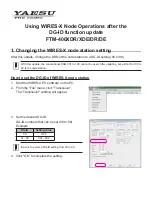
Page 53
O
PERATING
M
ANUAL
Microphone Tone Selection
Before setting up the speech processor, set the
selector switch on the rear of the
MH-31
B8D
microphone
(supplied) for the desired tone characteristic. The “
2
”
setting suppresses low frequencies, providing more
“pile-up punch” for DX operating. The “
1
” setting in-
creases the bass response, important for maximum
intelligibility when speaking in a language rich in vowel
sounds (such as Japanese).
RF Speech Processor
Once the proper MIC control setting has been deter-
mined, you can activate the RF speech processor to in-
crease the average power of your transmitted signal.
r
First set the
METER
selector to the “
ALC
” (Auto-
matic Level Control) position, and ensure the level
is within the red zone while speaking into the mi-
crophone.
r
Next set the
METER
selector to the
“
COMP
”(speech processor compression)
position, and press the [
PROC
] button (at
the left end of the row of buttons along the bottom)
so that its red LED lights.
r
Now while speaking into the micro-
phone, adjust the
PROC
control for
a compression level of 5 to 10 dB
on the COMP scale of the meter
(the second scale from the bottom).
If you have the monitor activated,
you will be able to hear the effect of the compres-
sion on your signal. In any case, we do not recom-
mend higher compression settings, as your signal
will actually become
less
readable. For the purposes
of making accurate adjustments, the long utterance
of the word “Four” usually provides a stable, full voice
waveform, ideal for setup of the RF speech pro-
cessor.
r
Finally, move the
METER
selector back to the “
PO
”
position, and (without touching the
MIC
control set-
ting) adjust the
RF PWR
control for the desired
power output on voice peaks.
Class-A Operation
A unique feature of the
MARK-V FT-1000MP
Field
is the capability to operate SSB in Class A. Switching
to Class A yields an ultra-linear transmitted signal, with
intermodulation distortion products
significantly
better
than possible with a typical Class AB
2
transmitter de-
sign.
Because Class A involves a total current dissipa-
tion much greater than utilized for Class AB, to which
you’re probably accustomed, maximum power output
during Class A is limited to 25 Watts as indicated on
the PO meter.
To enable this feature, press the orange [
CLASS-A
]
switch (located below and
to the left of the Main Tun-
ing dial) while operating ei-
ther in USB or LSB. During
Class-A operation, the PO meter will indicate up to 25
Watts of power output, while the IC meter will show a no-
modulation (constant) current of approximately 10 Amps.
Although the full advantage of Class-A operation
will be compromised somewhat when a (non-Class-A)
linear amplifier is used, the very clean drive power from
the
MARK-V FT-1000MP
Field
will, nonetheless, pro-
vide a significant improvement in overall signal quality.
T
RANSMITTING
O
PERATION
Carrier Point Offset
This feature allows shifting the carrier point IF pass-
band (and hence the RF passband as well) of your
transmitted signal in the SSB mode, to customize
your signal for your own voice characteristics.
Seven individual carrier settings can be user-ad-
justed:
USB Carrier
(Tx & Rx) - adjustable from –200 ~
+500 Hz.
LSB Carrier
(Tx & Rx) - adjustable from –200 ~
+500 Hz.
Processor Carrier
(USB & LSB) - adjustable from
–200 ~ +500 Hz.
AM Carrier
- adjustable ±3000 Hz.
To display and adjust the various carrier settings,
see
menu selection 8-9
. With the offset displayed,
you can adjust it throughout the ranges shown above
A minus sign indicates the offset is closer to the
carrier (low-frequency speech emphasized). You can
transmit during carrier display and adjustment.
Of course, you can adjust the offset by trial-and-
error on the air, but it is better to use the built-in
monitor circuit or a monitor receiver, in which you
can hear the effect yourself. Otherwise, we recom-
mend starting with +0.10 (+100 Hz) offset initially, to
add some “crispness” to your processed speech.
Summary of Contents for MARK-V FT-100MP
Page 119: ......
















































